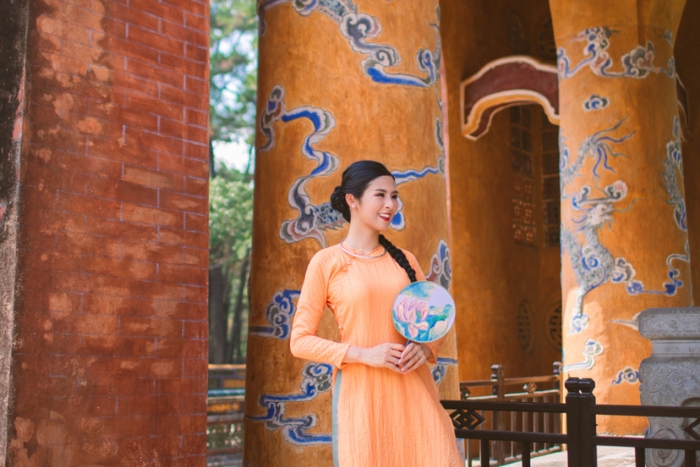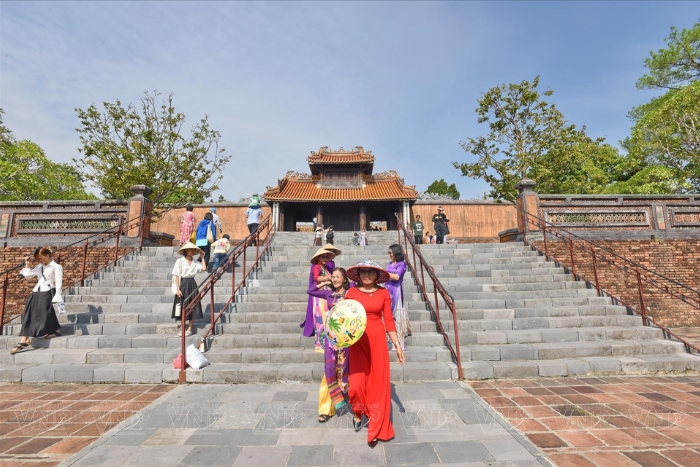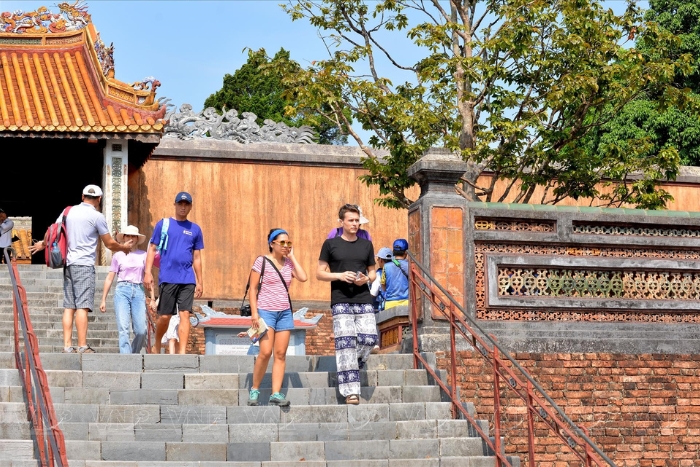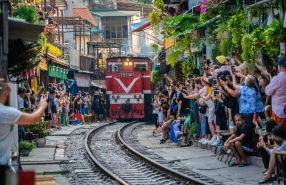 Without seeing the Tomb of Tu Duc, your trip to the enchanting city of Hue will not be complete. Let's examine this mysterious structure and discover what is on the other side of the gate. Tomb of Tu Duc is one of the most appealing Hue tourist destination to prior in your list for Hue What to do. Emperor Tu Duc has a strong affinity for art and poetry, which led him to build the picturesque Tu Duc Tomb in Hue. Until now, it is still the most romantic, imposing, and impressive of all royal mausoleums in Vietnam.
Without seeing the Tomb of Tu Duc, your trip to the enchanting city of Hue will not be complete. Let's examine this mysterious structure and discover what is on the other side of the gate. Tomb of Tu Duc is one of the most appealing Hue tourist destination to prior in your list for Hue What to do. Emperor Tu Duc has a strong affinity for art and poetry, which led him to build the picturesque Tu Duc Tomb in Hue. Until now, it is still the most romantic, imposing, and impressive of all royal mausoleums in Vietnam.
 About location, opening hours and entrance fee
About location, opening hours and entrance fee
Location: No. 17/69, Le Ngo Cat Street, Thuy Xuan Ward, Hue City, Thua Thien Hue Province
Tu Duc Tomb is a very convenient destination to visit for a day trip, as it is only 8 kilometers from the city center. The mausoleum is quietly situated in the middle of a vast pine forest in a little valley. You have an amazing view of the well-known Perfume River from this location.
Opening hours: 7:30 am - 5:30 pm daily
Entrance fee: 150,000 VND per adult, 30,000 VND per child
The meaningful value of Tu Duc Tomb
Tu Duc Tomb in Hue is still a must-see even though the location of Tu Duc's body is still unknown. Out of the seven tombs belonging to the Nguyen emperors, this one is the most elegant and well-kept. An excellent illustration of traditional Hue building that blends perfectly with the surrounding landscape is this world heritage site.
The Tu Duc Tomb is also the first site in Vietnam to be featured in Google Arts & Culture's 3D digitalization museum. It serves as a historical relic, offering insight into the life of an emperor who was endowed with gifts but endured a great deal of adversity.
The highlights of Tu Duc Tomb
Tu Duc, who ruled as King Thieu Tri's son, did so from 1847 until 1883. Vietnamese independence came to an end during his 35-year rule because he was unable to repel the relentless attacks of French colonialists. Tu Duc was ultimately coerced into signing a document that gave the French rule over three provinces in the Mekong Delta.
He was also forced to allow international trade to Hanoi, Hai Phong, and the Red River region. The Vietnamese people honored the fourth monarch of the Nguyen Dynasty for his literary legacy, especially his poems, even though he lost some of the country.
Being unable to produce children left the Tu Duc Emperor torn between his terrible personal life and the complicated conditions of his nation. So, in an attempt to shake off his melancholy, he created his own opulent getaway, a 12-hectare architectural masterpiece that took more than six years to complete. It is the modern-day Tu Duc Tomb.
What to see in Tu Duc Tomb?
The original name of Tu Duc tomb in Hue was "Van Nien Co" (Palace of Eternity). Thousands of people were forced to labor in appalling conditions from sunrise to midnight in order to construct the tomb, which sparked a rebellion.
The building was harshly criticized by the court following the uprising. Tu Duc tomb in Hue was called "Khiem Cung" by Tu Duc, which translates to "Palace of Modesty". These days, the entire complex's structures are connected to the English word "Khiem," which means "Modest."
Despite its notorious history, Tu Duc tomb Hue is still a sight to behold, consisting of five main parts:
Luu Khiem Lake and Tinh Khiem Islet
Visitors can enter Tu Duc tomb in Hue by walking down a brick-tiled pathway that starts at Vu Khiem Gate and ends at Khiem Cung Gate. There's a quiet lake called Luu Khiem in front of Khiem Cung Gate.
The late emperor thought this artificial lake, which was once a tiny stream, was a source of worth. There is no better location to admire the beauty of Vietnam's national flower than during the summer, when the lake is covered in lotuses in a variety of pink tones.
Tinh Khiem Islet is visible in the center of the lake. On this island, Tu Duc Emperor planted a wide variety of rare flowers, some of which are still flourishing now.
Luu Khiem Lake is also the location of the Du Khiem and Xung Khiem pavilions, where the emperor enjoyed tea, books, and sophisticated hobbies.
Hoa Khiem Palace
The next sight after passing through Khiem Cung Gate is Hoa Khiem Palace. Originally used as Tu Duc's workspace, this is now the emperor and his wife's place of devotion. The houses Phap Khiem Vu and Le Khiem Vu, where the servants stay, are located on both sides.
Luong Khiem Temple
Tu Duc Emperor, a devoted son, gave his mother, Empress Dowager Tu Du, a unique place. It's referred to as Luong Khiem Temple. The emperor's belongings are preserved in On Khiem Chamber, which is located directly next to the shrine.
Minh Khiem Ancient Theater
The Minh Khiem royal theater is the real centerpiece of Tu Duc Tomb for many visitors. This architectural piece, which overlooks the serene lake, is a reflection of Tu Duc's poetic nature. The ceiling was decorated with images of the sun, moon, and stars, and each pillar had elaborate carvings on it.
The emperor appreciated regal performances right here. Performances are being held in the Xung Khiem Pavilion in order to preserve the architecture. Nevertheless, this historic theater is worth seeing if you're into Vietnamese art, particularly the court music of Hue.
The Tomb Area
Immediately behind the place of worship is the first region, Bai Dinh. Two rows of sculptures that are exclusive to it are thought to have accompanied the emperor on his journey to the afterlife.
You will arrive at the Bi Dinh location after Bai Dinh, where a 20-ton stele with the emperor's handwriting on it is carved. This is Vietnam's largest stone stele by far. The plaque details Tu Duc's life, accomplishments, and downfall.
Travelers can arrive at Tu Duc Tom in Hue by traveling past Tieu Khiem, a green lake with a moon-like shape.
Three floors of stones make up the main tomb area. It's unclear if the emperor's body is actually present here. According to legend, the emperor's mourning entourage genuinely took a boat along Luu Khiem Lake and buried him in a hidden location after his passing.
To keep grave thieves from taking Tu Duc's remains, all of the servants were put to death after he was buried. And with them, the mystery surrounding Tu Duc's last resting place.
Review of clients on Tu Duc Tomb

“Beautiful space, with harmonious coordination between architectural landscape and surrounding nature. This is the resting place of King Tu Duc, a romantic king, rich in compassion and love of poetry. However, Tu Duc Tomb is that humility or weakness that leads us to fall into the arms of the French colonialists. So coming here to see the scene and look at his life to reflect on life and the world, how profound it is.” Review of Alexia from Google Map
“Tu Duc Tomb is spacious and airy, with a koi pond and two stilt houses to look down at the fish. Next to it there is also a pine forest. In the afternoon, there is a beautiful sunset. There is a bridge across the lake that people often film there. I find the mausoleum complex very poetic, with forests and lakes. You can wear clothes like me or ao dai or short shirt to take photos, it's all suitable for Hue What to do.” Review of Camila from Google Map
“The most beautiful mausoleum among the mausoleums in Hue, the scenery is poetic and lyrical, the system of their mausoleums is very majestic and solemn. In Tu Duc Tomb in Hue, there are many areas to visit, the palace area displays ancient images, dishes antiques, the king and queen's mausoleum area is quiet, the Pulse Khiem Ta area is cool, you can feed the fish and sit and enjoy the wind, very relaxing for Hue What to do.” Review of Alex Chocut from Google Map
The Tomb of Tu Duc is the embodiment of the sumptuous garden-villa complexes of the Nguyen Dynasty and stands as the apex of royal mausoleum design. It also marks the zenith of Vietnam's imperial tomb building throughout the monarchy. Of all the tombs from the Nguyen Dynasty in Hue, Tu Duc Tomb in Hue is still the most popular destination today, having been bestowed with a number of honors. After the Imperial City (Dai Noi), the official palace and workplace of the Nguyen emperors, it is ranked as the second most popular destination for Hue What to do.
What is the most famous royal tomb?
Tucked away outside of Hue is the beautiful Mausoleum of Emperor Minh Mang, a UNESCO World Heritage site. The Minh Mang Tomb, with its stunning surroundings, intricate construction, and captivating legends that portray the splendor of the Nguyen Dynasty, has captivated visitors and developed to become one of the most popular tourist spots in Hue.
Where to stay in Hue?
You will now also need to appreciate the elegance of 5-star hotels in Hue in addition to having to bow politely in front of the mausoleums and palaces in the Imperial Citadel.
 Without seeing the Tomb of Tu Duc, your trip to the enchanting city of Hue will not be complete. Let's examine this mysterious structure and discover what is on the other side of the gate. Tomb of Tu Duc is one of the most appealing Hue tourist destination to prior in your list for Hue What to do. Emperor Tu Duc has a strong affinity for art and poetry, which led him to build the picturesque Tu Duc Tomb in Hue. Until now, it is still the most romantic, imposing, and impressive of all royal mausoleums in Vietnam.
Without seeing the Tomb of Tu Duc, your trip to the enchanting city of Hue will not be complete. Let's examine this mysterious structure and discover what is on the other side of the gate. Tomb of Tu Duc is one of the most appealing Hue tourist destination to prior in your list for Hue What to do. Emperor Tu Duc has a strong affinity for art and poetry, which led him to build the picturesque Tu Duc Tomb in Hue. Until now, it is still the most romantic, imposing, and impressive of all royal mausoleums in Vietnam. About location, opening hours and entrance fee
About location, opening hours and entrance fee



























